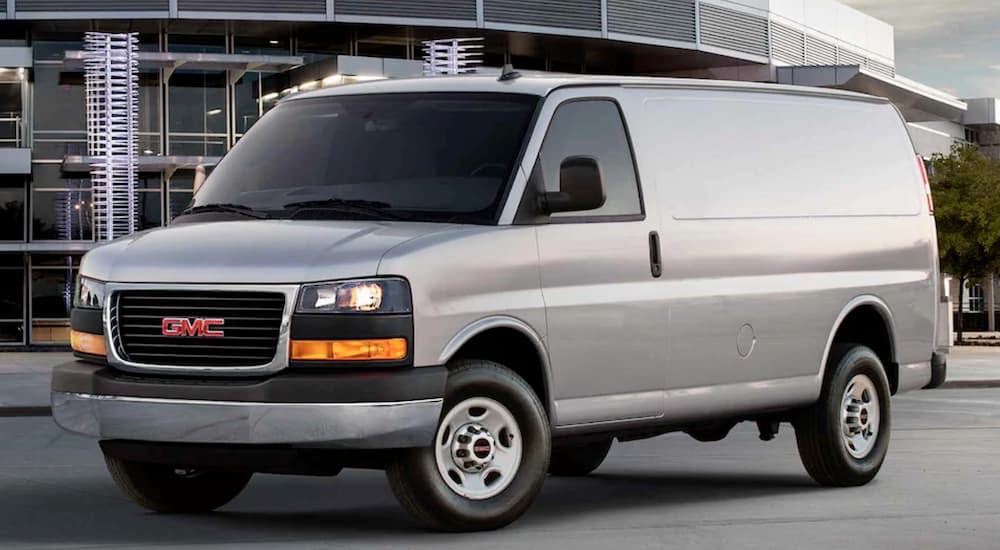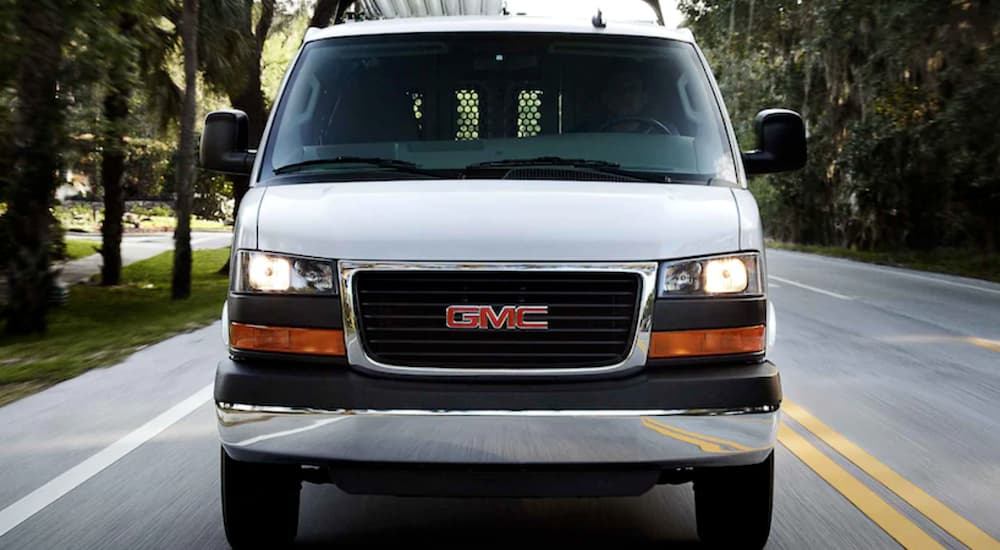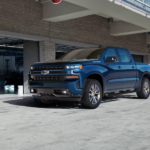The planet’s largest retailer, none other than Amazon, is almost entirely virtual, which means the millions of products ordered on its site every day need to find their way to us somehow. And Amazon is far from the only digital retailer out there. In 2019 alone, Americans received delivery of over 8.6 billion packages. That kind of volume requires a small army of delivery companies. Their vehicle of choice? Vans like the 2021 GMC work van. As writer Mike Colias put it in an article published on MarketWatch in December of last year, “the humble cargo van is having its moment.”
The gray Amazon delivery van is ubiquitous in neighborhoods, on busy city streets, and alongside us on the highway, and the fleet keeps growing. The last year has seen online shopping escalate by as much as 78%, and we’re likely to see the significant uptick in both van sales and package deliveries continue well into 2021. How are automakers responding to this spike in such an unlikely – and yes, humble – category?
They’re thinking on the fly, much like the rest of us during this season of uncertainty. The name of the game is agility, and businesses that operate in the retail supply chain are finding inventive ways to adapt as many consumers are stuck at home, relying more and more on home delivery for everything from clothing purchases to groceries. The cargo van has emerged as the story’s unlikely hero, and as automakers sort out their supply chains and boost production, the race is on to find ways to get packages to people and businesses quickly and efficiently.

EV Technology Is a Win-Win
Many manufacturers not commonly associated with building commercial vehicles are beefing up their offerings, including introducing new models, enhancing existing models, and increasing production capacities to allow for category expansion. Take General Motors: in a multi-billion-dollar effort, the stalwart manufacturing behemoth is showing signs of market awareness and agility by planning the production of an electric commercial van as soon as late 2021. The company plans to beat Tesla to the market, much like they did with the entry-level Bolt EV, a sub-$40,000 compact electric vehicle.
It’s likely that the future GM electric van will wear a GMC badge, but the company hasn’t released its final plans yet. GM likes the level playing field provided by the cargo van category. Here, nameplates and the ‘cool factor’ matter far less than reliability, a factor that weighs heavily in the Big 3’s favor. Assuming GM releases the first commercial electric van, how will that affect auto manufacturing and large online retailers like Amazon?
The addition of electric power changes the business model for companies like Amazon. Currently, Amazon spends billions on delivery costs every year, so paying a little more upfront for EV technology that saves on gas and maintenance costs is a great trade-off. That investment comes with the added benefit of helping companies like General Motors offset their EV R&D costs for other non-commercial vehicles.
It’s Not Just Amazon
Companies like UPS and FedEx rely heavily on commercial cargo van fleets to undergird their supply chains and keep packages moving efficiently, especially in heavily populated areas in and around large cities. Full-size tractor-trailers aren’t always conducive to quick turnaround times and navigating winding residential streets. All this demand for fleets of agile cargo vans is fueling a van shortage across the industry.
Bloomberg reports that UPS is paying its contractors a stipend to “offset the extra cost of renting [a van].” Small fleet companies find themselves in bidding wars to acquire even the oldest, most poorly maintained vans. Some large companies have seen a 250% increase in van leases from package delivery companies this year alone. Automotive factory shutdowns that slowed production have only further fueled the van shortage.
As we move into 2021, market watchers will keep a close eye on cargo van production and how companies like Amazon adapt to changing consumer buying trends. Will there be a return to traditional brick-and-mortar retail, or will customers continue buying mostly online? According to the news site Quartz, online shopping grew from 4% of overall sales in 2010 to 12% in 2019. Flash forward to 2020, and in a single quarter, that number jumped to 16.1%. Automakers need to maintain a spirit of agility to adjust to buying trends. Anticipating consumer behavior isn’t easy, and it’s even less predictable now.
How Automakers Are Adjusting
Back in 2016, the industry recognized the surge in van sales as a trend that wasn’t going away anytime soon. Automotive News called the van category “one of the fastest-growing, most lucrative vehicle segments” and pointed out how dealer networks were dedicating specially-trained sales staff to support commercial cargo van buyers. On the back end, Service Departments saw an equal boost in business as they struggled to keep up with maintaining large commercial van fleets for business customers.
Manufacturers are refining their fleet and commercial vehicle dealer support programs to better equip dealer networks with training tools and commercial sales support. In 2017, Ford launched its Commercial Vehicle Center program. The program, which was initially rolled out to 650 dealers, created Commercial Vehicle Centers with extended service hours and larger parts inventories. A complimentary customer loyalty program helps feed fleet sales and encourage dealer fleet service agreements.
Back in 2016, Automotive News reported that full-size van sales were growing approximately eight times faster than the industry average. Not only has that trend continued, but 2020 saw off-the-charts category sales increases. That increase in demand requires a more robust dealer network that is equipped with the tools, equipment, and training programs necessary to support commercial customers. Programs like Ford’s Commercial Vehicle Center program bridge the gap and provide dealers with much-needed factory support.
Increasing manufacturing volume also requires infrastructure investment. GM manufactures its current line of cargo vans at the company’s 3.7 million square foot factory in Wentzville, Missouri. Factory space is already being allocated to the upcoming EV vans, demonstrating the company’s commitment to infrastructure that supports its mission. GM has also begun constructing a three-million square foot Ultium battery cell manufacturing facility in Lordstown, Ohio. Part of a joint venture with its battery partner, LG Chem, the facility is rumored to cost roughly $2.3 billion and stands to generate over 1,000 new jobs.
All evidence points to the demand for commercial cargo vans continuing to increase rapidly. Whether we look at metrics like online sales or pick up on cues from delivery companies like UPS and FedEx, the consistent message is that auto manufacturers and the dealers that sell their vehicles are poised for exponential growth. The onus is on them to create an infrastructure that facilitates commercial van sales and a team of experts that supports the customers that buy them.
It used to be that dealers located in dense urban environments were poised to benefit the most, but with the recent news that Amazon plans to build over 1,000 warehouses everywhere from inner cities to remote, suburban enclaves, it’s likely commercial delivery vans will dispatch from just about everywhere. The modern economy runs on fleets of cargo vans to deliver the unending supply of packages to homes and businesses, so it’s likely this category will continue growing right along with e-commerce businesses.





